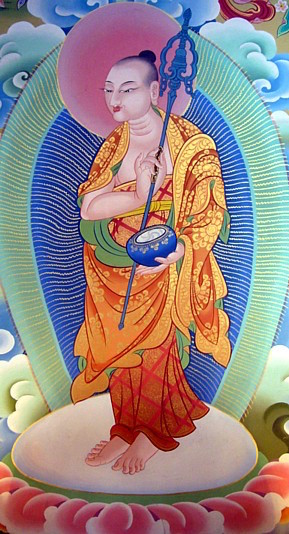Maudgalyayana
Maudgalyāyana (P. Moggallāna; T. mo'u 'gal gyi bu མོའུ་འགལ་གྱི་བུ་; C. mujianlian/mulian 摩訶目犍連/目連), also known as Mahāmaudgalyāyana, was one of the two chief disciples of Gautama Buddha, together with Śāriputra.
"The Buddha declared Śāriputra and Mahāmaudgalyāyana his chief disciples the day they were ordained, giving as his reason the fact that both had exerted themselves in religious practice for countless previous lives. Śāriputra was declared chief among the Buddha’s disciples in wisdom, while Mahāmaudgalyāyana was chief in mastery of supranormal powers (ṛddhi)."[1]
Traditional accounts relate that Maudgalyāyana and Śāriputra become spiritual wanderers in their youth. After having searched for spiritual truth for a while, they come into contact with the Buddhist teachings. Eventually they meet the Buddha himself and ordained as monks under him. Maudgalyāyana attains enlightenment shortly after that.
Maudgalyayana and Śāriputra are depicted in Buddhist art as the two disciples that accompany the Buddha, and they have complementing roles as teachers. As a teacher, Maudgalyayana is known for his psychic powers (ṛddhi), and he is often depicted using these in his teaching methods. In early Buddhist texts, Maudgalyāyana is instrumental in re-uniting the monastic community after Devadatta causes a schism. Maudgalyāyana dies at the age of eighty-four, killed through the efforts of a rival sect. This violent death is described in Buddhist scriptures as a result of Maudgalyāyana's karma from a previous life.
Through post-canonical texts, Maudgalyāyana became known for his filial piety through a popular account of him transferring his merit to his mother. Maudgalyāyana has also traditionally been associated with meditation and sometimes Abhidharma texts, as well as the Dharmaguptaka school.
Notes
- ↑ Buswell & Lopez 2014, s.v. Śāriputra.
Sources
 Buswell, Robert E.; Lopez, Donald S. (2014), The Princeton Dictionary of Buddhism, Princeton University
Buswell, Robert E.; Lopez, Donald S. (2014), The Princeton Dictionary of Buddhism, Princeton University
Further reading
- Maudgalyayana (Wikipedia)
 Nyanaponika Thera; Hecker, Hellmuth (2003), Great Disciples of the Buddha: Their Lives, Their Works, Their Legacy (PDF), Wisdom Publications
Nyanaponika Thera; Hecker, Hellmuth (2003), Great Disciples of the Buddha: Their Lives, Their Works, Their Legacy (PDF), Wisdom Publications
| This article includes content from Maudgalyayana on Wikipedia (view authors). License under CC BY-SA 3.0. |
